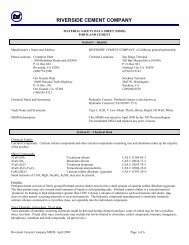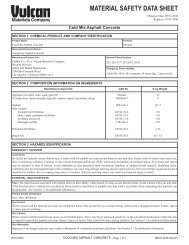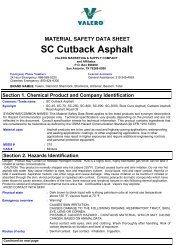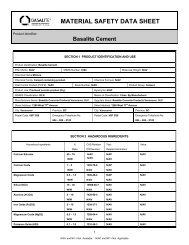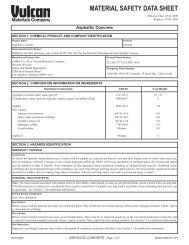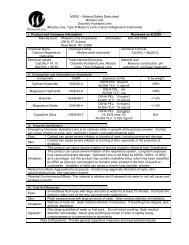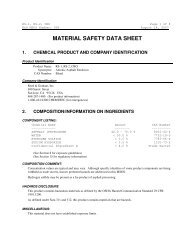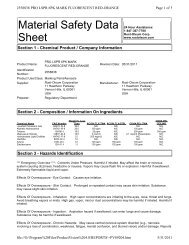Sand, Gravel, Crushed Rock - CALVAC Paving
Sand, Gravel, Crushed Rock - CALVAC Paving
Sand, Gravel, Crushed Rock - CALVAC Paving
- No tags were found...
You also want an ePaper? Increase the reach of your titles
YUMPU automatically turns print PDFs into web optimized ePapers that Google loves.
Material Safety Data Sheet<br />
SECTION I – PRODUCT IDENTIFICATION<br />
Product Name: <strong>Sand</strong>, <strong>Gravel</strong>, <strong>Crushed</strong> <strong>Rock</strong> Synonym: Aggregates, Traprock<br />
Manufacture’s Name: Syar Industries, Inc. Emergency Telephone Number:<br />
(707) 252-8711<br />
Address:<br />
2301 Napa-Vallejo Highway<br />
P.O. Box 2540<br />
Napa, CA 94558<br />
Information Telephone Number:<br />
(707) 252-8711<br />
DOT shipping Name: None<br />
UN/NA Number: None<br />
SECTION II – PRODUCT AND COMPONENT DATA<br />
Component: CAS#: Approximate %:<br />
Natural <strong>Sand</strong>, <strong>Rock</strong>, and <strong>Gravel</strong>*<br />
None<br />
100<br />
*Typically contains Quartz<br />
(Crystalline Silica)<br />
14808-60-7<br />
1-20<br />
SECTION III – PHYSICAL/CHEMICAL CHARACTERISTICS<br />
Boiling Point: N/A Specific Gravity: 2.20-2.85<br />
Vapor Pressure (mm Hg.): 0 Evaporation Rate (Butyl Acetate = 1): 0<br />
Vapor Density (Air=1): 0<br />
Solubility In Water: N/A<br />
Appearance And Odor: Rounded and/or angular particles of various shapes and colors with no odor<br />
SECTION IV – FIRE AND EXPLOSION HAZARD DATA<br />
Flash Point (Method Used):N/A<br />
Flammable Limits in Air: Not Flammable<br />
Extinguishing Media: None required Special Fire Fighting Procedures: None<br />
Unusual Fire and Explosion Hazards: N/A<br />
SECTION V – REACTIVITY DATA<br />
Stability: Stable<br />
Conditions to Avoid: N/A<br />
Incompatible Materials (Materials to Avoid): N/A<br />
Hazardous Decomposition or Byproducts: None<br />
Hazardous Polymerization: None<br />
SECTION VI – HEALTH HAZARD DATA<br />
Primary Routes of Entry : X Inhalation Skin Ingestion<br />
ACUTE TOXICITY :<br />
Eye Contact: Direct contact with dust may cause irritation.<br />
Skin Contact: Direct contact may cause irritation or abrasion.<br />
Skin Absorption: Negligible<br />
Ingestion: Not expected to be a problem. Ingestion of large amounts may cause gastrointestinal<br />
irritation and blockage.<br />
Inhalation: Dust may irritate the nose, throat, and respiratory tract by mechanical abrasion. Coughing,<br />
sneezing, and shortness of breath may occur following exposure in excess of exposure limits.<br />
Syar Industries, Inc. Last Revised: 07/11/2007<br />
Material Safety Data Sheet Page 1 of 3
Other information: The use of natural sand, gravel, and crushed rock for construction purposes is not<br />
believed to cause additional acute toxic effects. Howeer, repeated overexposure to very high levels of<br />
respirable crystalline silica (quartz, tridymite, cristobalite) for periods as short as six months have caused<br />
acute silicosis. Acute silicosis is a rapidly progressive, incurable lung disease.<br />
CHRONIC TOXICITY:<br />
Prolonged and repeated inhalation of respirable crystalline silica-containing dust in excess of exposure<br />
limits may cause a delayed lung injury known as silicosis. Silicosis is a form of disabling pulmonary<br />
fibrosis which can be progressive and may lead to death. Not all individuals with silicosis will exhibit<br />
symptoms of the disease. However, silicosis can be progressive and symptoms can appear at any time.<br />
Symptoms of silicosis may include, but are not limited to, shortness of breath, difficulty of breathing,<br />
coughing, diminished work capacity, diminished chest expansion, reduction of lung volume, right heart<br />
enlargement or failure. Smoking may increase the risk of developing lung disorders, including emphysema<br />
and lung cancer. Individuals with silicosis have an increased risk of pulmonary tuberculosis infection.<br />
There are reports in the literature suggesting that excessive exposure to crystalline silica may be associated<br />
with adverse health effects involving the kidney, scleroderma (thickening of the skin caused by swelling<br />
and thickening of fibrous tissue) and other auto immune disorders. However, this evidence has been<br />
obtained primarily from case reports involving workers in high exposure situation (such as sand blasting)<br />
who have already developed silicosis, and therefore, this evidence does not conclusively prove a causal<br />
relationship between silica or silicosis and those adverse health effects. Several studies of persons with<br />
silicosis also indicate an increase risk of developing lung cancer. This extent of this risk depends on the<br />
concentration and duration of exposure. Many of these studies of silicosis do not account for lung cancer<br />
cofounders, especially smoking.<br />
<strong>Sand</strong>, gravel, and crushed rock are not listed as a carcinogen by the International Agency for Research on<br />
Cancer (IARC), the National Toxicology Program (NTP) or the Occupational Safety and Health<br />
Association (OSHA). Crystalline silica, a component of this product, has been designated by the IARC as<br />
a Group 1 carcinogen. The NTP indicates that crystalline silica is reasonably anticipated to be a carcinogen<br />
(Group 2). These classifications are based on sufficient evidence of carcinogenity in certain experimental<br />
animals and on selected epidemiological studies of workers exposed to crystalline silica.<br />
WARNING: This product contains crystalline silica which is known to the State of California to cause<br />
cancer.<br />
MEDICAL CONDITIONS AGGREVATED BY EXPOSURE: Inhaling respirable dust<br />
and/or crystalilne silica may agravate existing respirable system disease(s) and/or disfunctions. Exposue to<br />
dust may aggravate existing skin and/or eye conditions.<br />
FIRST AID:<br />
Eyes: Flush material and particles from eyes for 15 minutes while holding the eyelids open. If unable to<br />
flush particles from eyes and/or irritation persists, get medical attention.<br />
Skin: Wash thoroughly with soap and water. If irritation persists, get medical attention.<br />
Ingestion: If victim is conscious, give large quantities of water and induce vomiting. Seek medical<br />
attention.<br />
Inhalation: Remove victim to fresh air. If breathing is difficult or has stopped, give oxygen or artificial<br />
respiration. Dust in nose and throat should clear spontaneously. Seek medical attention if breathing<br />
remains difficult or irritatiosn persists.<br />
EXPOSURE LIMITS:<br />
Other Particulate: TLV = 10 mg/m3 (inhalable particulate, not otherwise classified); TLV = 3 mg/m<br />
(respirable particulate, not otherwise classified); OSHA PEL = 15 mg/m3 (total particulate, not otherwise<br />
regulated).<br />
Respirable Crystalline Silica (quartz): TLV = 0.1 mg/m3, MSHA and OSHA PEL = 10 mg/m3 +<br />
(%SiO2 +2)<br />
Respirable Dust: MSHA and OSHA PEL = 10 mg/m3 + (%SiO2 +2)<br />
Total Dust: MSHA PEL = 30 mg/m3 + (%SiO2+3); OSHA PEL = 30 mg/m3 + (SiO2+2)<br />
Syar Industries, Inc. Last Revised: 07/11/2007<br />
Material Safety Data Sheet Page 2 of 3
Abbreviations: TLV = threshold limit value of the American Conference of Governmental Industrial<br />
Hygienist (ACGIH); MSHA PEL = permissible exposure limit of the Mine Safety and Health<br />
Administration (MSHA); OSHA PEL = permissible exposure limit of the Occupational Safety and Health<br />
Administration; mg/m3 = milligrams of substance per cubic meter of air.<br />
SECTION VII – PERSONAL PROTECTION AND CONTROLS<br />
Respiratory Protection: When exposure exceeds or may exceed exposures listed in Section VI of<br />
this MSDS, a NIOSH/MSHA approved respirator must be worn.<br />
Ventilation: Use local exhaust or mechanical ventilation to maintain exposures below PEL's and TLV's.<br />
Eye Protection: Use tight fitting goggles or safety glasses with side shields.<br />
Skin Protection: Use protective gloves, industrial clothing, and safety shoes to prevent abrasions.<br />
Work/Hygiene Practices: Wash hands and skin with soap and water before eating and drinking.<br />
Wash clothes after each use and shower each day.<br />
SECTION VIII – PRECAUTIONS FOR SAFE HANDLING AND USE<br />
Steps to Be Taken in Case Material is Released or Spilled: Prevent dust from entering lakes<br />
and streams. Wet material to prevent dust generation during cleanup. Do not dry sweep the material.<br />
Waste Disposal Method: Follow local, state, and federal regulations for disposal of this material.<br />
Reuse uncontaminated material.<br />
Precautions to Be Taken in Handling and Storage: Avoid creating dust and prolonged<br />
exposure to dust without respiratory protection. Respirable crystalline silica dust may be generated during<br />
handling and storage.<br />
Other Precautions: OSHA requires pulmonary function tests prior to the use of respiratory protection.<br />
SECTION IX - TRANSPORTATION<br />
DOT Hazard Classification: None<br />
Placard Required: None<br />
Label Required: Label as required by the OSHA Hazard Communication Standard (29 CFR 1910.100<br />
(f)) and applicable state and local laws and regulations.<br />
The information contained herein is provided in good faith and is believed to be<br />
correct as of the date hereof. However, Syar Industries, Inc. and Syar Concrete,<br />
LLC., makes no representation as to the comprehensiveness or accuracy of the<br />
information. It is expected that the individuals receiving this information will<br />
exercise their independent judgment in determining its appropriateness for a<br />
particular purpose. No warranties or guarantees of any kind are made hereunder<br />
with respect to the information and the recommendations set forth herein or to<br />
which the information refers. The information and recommendations contained<br />
herein are offered for the user’s consideration and examination, and Syar<br />
Industries, Inc. disclaims any liability for damage or injury which results from the<br />
proper or improper use of this product.<br />
Date Prepared: 07/11/2007<br />
Syar Industries, Inc. Last Revised: 07/11/2007<br />
Material Safety Data Sheet Page 3 of 3



